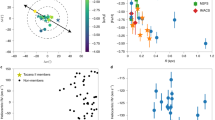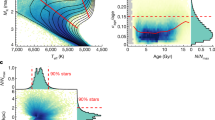Abstract
Small stellar systems such as dwarf galaxies are suggested to be the main building blocks of our Galaxy according to numerical simulations1 in Λ cold dark matter models and observational support for this hypothesis comes from the existence of stellar streams such as the Sagittarius tidal stream2. However, it is unclear how many and what kind of stars in our Galaxy originate from satellite dwarf galaxies, something that could be constrained by analysing chemical abundances of metal-poor stars. Here we report on the discovery of a metal-poor star with an extreme r-process enhancement and α-element deficiency. In this star, the abundance ratio of the r-process element Eu with respect to Fe is more than one order of magnitude larger than the Sun and the metallicity is 1/20 of solar metallicity. Stars like this one have been found in present-day dwarf galaxies, providing the clearest chemical signature of past accretion events onto the Milky Way. The long timescale of chemical evolution of the host dwarf galaxy expected from the abundance of α-elements with respect to Fe suggests that the accretion occurred in a relatively late phase compared with most of the accretions that formed the bulk of the Milky Way halo.
This is a preview of subscription content, access via your institution
Access options
Access Nature and 54 other Nature Portfolio journals
Get Nature+, our best-value online-access subscription
$29.99 / 30 days
cancel any time
Subscribe to this journal
Receive 12 digital issues and online access to articles
$119.00 per year
only $9.92 per issue
Buy this article
- Purchase on Springer Link
- Instant access to full article PDF
Prices may be subject to local taxes which are calculated during checkout



Similar content being viewed by others
Data availability
The data that support the plots within this paper and other findings of this study are available from the corresponding author upon reasonable request.
References
Bullock, J. S. & Johnston, K. V. Tracing galaxy formation with stellar halos. I. Methods. Astrophys. J. 635, 931–949 (2005).
Ibata, R., Gilmore, G. & Irwin, M. J. A dwarf satellite galaxy in Sagittarius. Nature 370, 194–196 (1994).
Tinsley, B. M. Stellar lifetimes and abundance ratios in chemical evolution. Astrophys. J. 229, 1046–1056 (1979).
McWilliam, A. Abundance ratios and galactic chemical evolution. Annu. Rev. Astron. Astrophys. 35, 503–556 (1997).
Ivans, I. I. et al. Chemical substructure in the milky way halo: a new population of old stars. Astrophys. J. 592, 906–934 (2003).
Caffau, E. et al. X-shooter GTO: evidence for a population of extremely metal-poor, alpha-poor stars. Astron. Astrophys. 560, A15 (2013).
Tolstoy, E., Hill, V. & Tosi, M. Star-formation histories, abundances, and kinematics of dwarf galaxies in the Local Group. Annu. Rev. Astron. Astrophys. 47, 371–425 (2009).
Letarte, B. et al. A high-resolution VLT/FLAMES study of individual stars in the centre of the Fornax dwarf spheroidal galaxy. Astron. Astrophys. 523, A17 (2010).
Kobayashi, C., Ishigaki, M. N., Tominaga, N. & Nomoto, K. The origin of low [α/Fe] ratios in extremely metal-poor stars. Astrophys. J. 785, L5 (2014).
Xing, Q. F. & Zhao, G. Mining the Sloan Digital Sky Survey in search of extremely α-poor stars in the Galaxy. Astrophys. J. 790, 33 (2014).
Xing, Q. F. & Zhao, G. Newly discovered alpha-poor stars in the solar neighborhood. Astrophys. J. 805, 146 (2015).
Zhao, G. et al. LAMOST spectral survey—an overview. Res. Astron. Astrophys. 12, 723–734 (2012).
Noguchi, K. et al. High dispersion spectrograph (HDS) for the subaru telescope. Publ. Astron. Soc. Jpn 54, 855–864 (2002).
Castelli, F., Gratton, R. G. & Kurucz, R. L. Notes on the convection in the ATLAS9 model atmospheres. Astron. Astrophys. 318, 841–869 (1997).
Arlandini, C. et al. Neutron capture in low-mass asymptotic giant branch stars: cross sections and abundance signatures. Astrophys. J. 525, 886–900 (1999).
Hansen, T. T. et al. An r-process enhanced star in the dwarf galaxy Tucana III. Astrophys. J. 838, 44 (2017).
Roederer, I. U. et al. The r-process alliance: a comprehensive abundance analysis of HD 222925, a metal-poor star with an extreme r-process enhancement of [Eu/H] = −0.14. Astrophys. J. 865, 129 (2018).
Hansen, T. T. et al. The r-process alliance: first release from the southern search for r-process-enhanced stars in the Galactic halo. Astrophys. J. 858, 92 (2018).
Howes, L. et al. The EMBLA survey—metal-poor stars in the Galactic bulge. Mon. Not. R. Astron. Soc. 460, 884–901 (2016).
Aoki, W., Honda, S., Sadakane, K. & Arimoto, N. First determination of the actinide thorium abundance for a red giant of the ursa minor dwarf galaxy. Publ. Astron. Soc. Jpn 59, 15–19 (2007).
Travaglio, C. et al. Galactic evolution of Sr, Y, and Zr: a multiplicity of nucleosynthetic processes. Astrophys. J. 601, 864–884 (2004).
Ji, A. P., Frebel, A., Chiti, A. & Simon, J. D. R-process enrichment from a single event in an ancient dwarf galaxy. Nature 531, 610–613 (2016).
Hirai, Y. et al. Early chemo-dynamical evolution of dwarf galaxies deduced from enrichment of r-process elements. Mon. Not. R. Astron. Soc. 466, 2474–2487 (2017).
Kasen, D. et al. Origin of the heavy elements in binary neutron-star mergers from a gravitational-wave event. Nature 551, 80–84 (2017).
Nishimura, N., Takiwaki, T. & Thielemann, F. K. The r-process nucleosynthesis in the various jet-like explosions of magnetorotational core-collapse supernovae. Astrophys. J. 810, 109 (2015).
Lindegren, L. et al. Gaia Data Release 2. Astron. Astrophys. 616, A2 (2018).
Bailer-Jones, C. A. L. et al. Estimating distance from parallaxes. IV. Distances to 1.33 billion stars in Gaia Data Release 2. Astron. J. 156, 2 (2018).
Sneden, C. A. Carbon and Nitrogen Abundances in Metal-poor Stars. PhD thesis, Univ. Texas, Austin (1973).
Ivans, I. I. et al. Near-ultraviolet observations of HD 221170: new insights into the nature of r-process-rich stars. Astrophys. J. 645, 613–633 (2006).
Ishigaki, M. N., Aoki, W. & Chiba, M. Chemical abundances of the Milky Way thick disk and stellar halo. II. Sodium, iron-peak, and neutron-capture elements. Astrophys. J. 771, 67 (2013).
Lind, K., Asplund, M., Barklem, P. S. & Belyaev, A. K. Non-LTE calculations for neutral Na in late-type stars using improved atomic data. Astron. Astrophys. 528, 103 (2011).
Xing, Q. F. & Zhao, G. Evidence for accreted component in the Galactic discs. Mon. Not. R. Astron. Soc. 476, 5388–5392 (2018).
Bovy, J. galpy: a python library for Galactic dynamics. Astrophys. J. Suppl. 216, 2 (2015).
Frebel, A. Stellar archaeology: exploring the Universe with metal-poor stars. Astron. Nachr. 331, 474–488 (2010).
Roederer, I. U., Hattori, K. & Valluri, M. Kinematics of highly r-process-enhanced field stars: evidence for an accretion origin and detection of several groups from disrupted satellites. Astron. J. 156, 179 (2018).
Suda, T. et al. The stellar abundances for galactic archaeology (SAGA) database—IV. Compilation of stars in dwarf galaxies. Publ. Astron. Soc. Jpn 69, 76 (2017).
Asplund, M., Grevesse, N., Sauval, A. J. & Scott, P. The chemical composition of the Sun. Annu. Rev. Astron. Astrophys. 47, 481–522 (2009).
Acknowledgements
Support for this work was provided by the National Natural Science Foundation of China grant numbers 11890694, 11390371, 11603033, 11573032 and 11773033. This research was supported by JSPS-CAS Joint Research Program. W.A. was supported by JSPS KAKENHI grant number 16H02168. M.N.I. was supported by JSPS KAKENHI grant number 17K14249. This paper includes data collected at the Subaru Telescope, which is operated by the National Astronomical Observatory of Japan. Funding for LAMOST (www.lamost.org) has been provided by the Chinese NDRC. LAMOST is operated and managed by the National Astronomical Observatories, CAS.
Author information
Authors and Affiliations
Contributions
Q.-F.X. is responsible for the data analysis and paper draft. G.Z. proposed and initiated this research subject. W.A. and T.M. obtained the high-resolution spectra. H.-N.L., S.H. and M.N.I. assisted Q.-F.X with the data reduction and interpretation of observed chemical abundances. The manuscript was further revised by Q.-F.X., G.Z. and W.A. with all authors contributing comments and suggestions.
Corresponding authors
Ethics declarations
Competing interests
The authors declare no competing interests.
Additional information
Journal peer review information: Nature Astronomy thanks Rana Ezzeddine and Terese Hansen for their contribution to the peer review of this work.
Publisher’s note: Springer Nature remains neutral with regard to jurisdictional claims in published maps and institutional affiliations.
Supplementary information
Supplementary Information
Supplementary Figures 1 and 2.
Rights and permissions
About this article
Cite this article
Xing, QF., Zhao, G., Aoki, W. et al. Evidence for the accretion origin of halo stars with an extreme r-process enhancement. Nat Astron 3, 631–635 (2019). https://doi.org/10.1038/s41550-019-0764-5
Received:
Accepted:
Published:
Issue Date:
DOI: https://doi.org/10.1038/s41550-019-0764-5
This article is cited by
-
A metal-poor star with abundances from a pair-instability supernova
Nature (2023)
-
Progress in nuclear astrophysics of east and southeast Asia
AAPPS Bulletin (2021)



